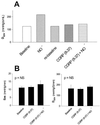Nitroxyl anion exerts redox-sensitive positive cardiac inotropy in vivo by calcitonin gene-related peptide signaling
- PMID: 11517312
- PMCID: PMC56983
- DOI: 10.1073/pnas.181191198
Nitroxyl anion exerts redox-sensitive positive cardiac inotropy in vivo by calcitonin gene-related peptide signaling
Abstract
Nitroxyl anion (NO(-)) is the one-electron reduction product of nitric oxide (NO( small middle dot)) and is enzymatically generated by NO synthase in vitro. The physiologic activity and mechanism of action of NO(-) in vivo remains unknown. The NO(-) generator Angeli's salt (AS, Na(2)N(2)O(3)) was administered to conscious chronically instrumented dogs, and pressure-dimension analysis was used to discriminate contractile from peripheral vascular responses. AS rapidly enhanced left ventricular contractility and concomitantly lowered cardiac preload volume and diastolic pressure (venodilation) without a change in arterial resistance. There were no associated changes in arterial or venous plasma cGMP. The inotropic response was similar despite reflex blockade with hexamethonium or volume reexpansion, indicating its independence from baroreflex stimulation. However, reflex activation did play a major role in the selective venodilation observed under basal conditions. These data contrasted with the pure NO donor diethylamine/NO, which induced a negligible inotropic response and a more balanced veno/arterial dilation. AS-induced positive inotropy, but not systemic vasodilatation, was highly redox-sensitive, being virtually inhibited by coinfusion of N-acetyl-l-cysteine. Cardiac inotropic signaling by NO(-) was mediated by calcitonin gene-related peptide (CGRP), as treatment with the selective CGRP-receptor antagonist CGRP(8-37) prevented this effect but not systemic vasodilation. Thus, NO(-) is a redox-sensitive positive inotrope with selective venodilator action, whose cardiac effects are mediated by CGRP-receptor stimulation. This fact is evidence linking NO(-) to redox-sensitive cardiac contractile modulation by nonadrenergic/noncholinergic peptide signaling. Given its cardiac and vascular properties, NO(-) may prove useful for the treatment of cardiovascular diseases characterized by cardiac depression and elevated venous filling pressures.
Figures




References
Publication types
MeSH terms
Substances
Grants and funding
LinkOut - more resources
Full Text Sources
Other Literature Sources
Research Materials

